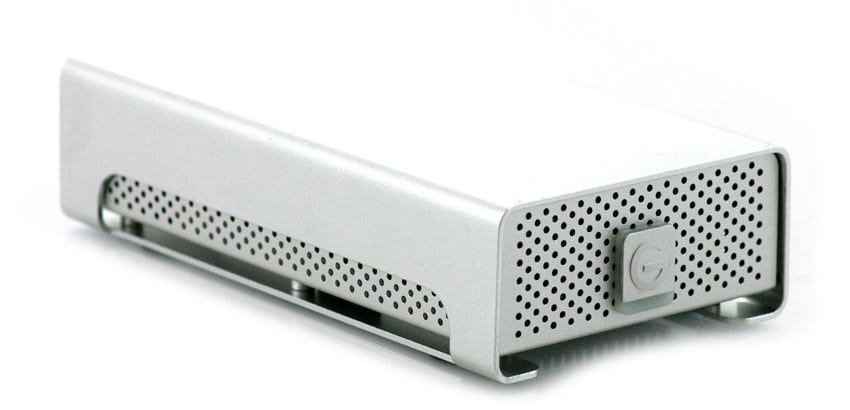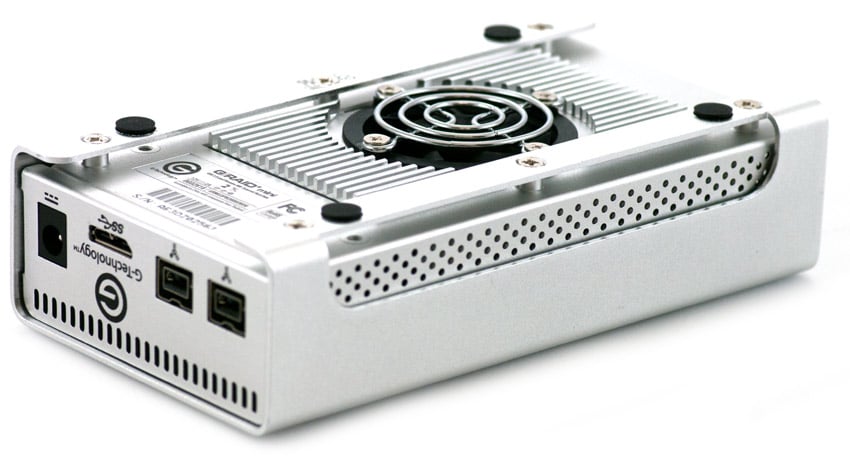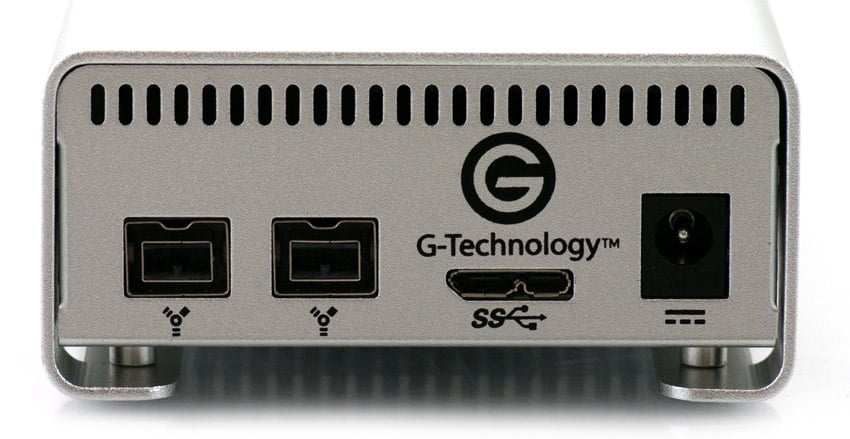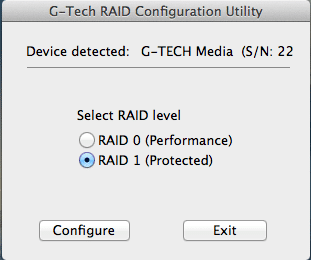
The G-RAID mini from HGST G-Technology is an external storage device that now features up to 2TB of total capacity, interfaces over USB 3.0 or FireWire 800, and enables users to implement either a RAID 0 or RAID 1 configuration for performance or data security needs. The drive features robust performance capabilities which it derives from the two 7,200 RPM hard drives that are fitted inside its compact, rigid enclosure. That enclosure implements the same design features that G-Technology delivered in the G-DRIVE mini and G-DRIVE 4TB devices that we recently reviewed, and it gives creative professionals on the go improved options for their mobile data needs.

G-Technology is driving simplicity of setup and maximum throughput with the G-RAID mini. The device is ready to go with minimal installation as it is preformatted for Mac OS X systems; for Windows systems, a simple reformat is all users will need to do to setup the device. Furthermore, with a downloadable utility, users can configure the G-RAID mini to RAID 0 to optimize it for performance or they can setup the device up in RAID 1 to keep critical data safe by storing a duplicate copy. Another feature designed to keep the device free from failure is the thermal solution in the form of an integrated heat sink and a quiet-cooling fan.
The G-RAID mini is priced at $249.95 for the 1TB model and $449.95 for the 2TB model. The device is also backed by a standard 3-year warranty. Our review model is the 2TB capacity.
G-Technology G-RAID mini 2TB Specifications
- Capacity
- 1TB (0G02608)
- 2TB (0G02616)
- HDD: 2 x 7,200 RPM 2.5" HDDs (HGST 7K1000)
- 32MB cache
- Interface: 1xUSB 3.0, 2xFireWire 800
- Included in box: 1 USB 3.0 cable, 2 FireWire cables (800 to 800; 800 to 400)
- Cooling System: Integrated heat sink, quiet-cooling fan
- Size (LxWxH): 5.875" x 3.25" x 1.5" / 149mm x 83mm x 38 mm
- Weight: 2.2 lb / 1 kg
Design and Build
The G-RAID mini follows in the footsteps of the G-DRIVE mini and G-DRIVE models that feature rigid, aluminum exterior constructions to provide maximum security for the drives inside. On top of that, the brushed aluminum ensures that the G-RAID mini will match well with the Mac environments in which the drive is likely to be installed.
The front of the enclosure houses the G-Technology logo and an access LED behind the ventilated front grille. The sides of the G-RAID mini also feature ventilation. The bottom portion of the G-RAID mini is highlighted by a quiet-operating fan as well as a relatively large heat sink. Shifting around to the back, that’s where we find the connectivity. There are two FireWire ports, a USB 3.0 port, and the power input to hookup the included power supply. The drive must use the power supply when interfacing via USB 3.0, though users accessing the device via FireWire don’t have to use the power supply.
The exterior of the G-RAID mini is part of a two-piece build that is removable by unscrewing six screws. Removing the sled portion, there are two HGST 7K1000 HDDs inside, which is the same drive featured in the G-DRIVE mini. The drives are held securely in place with additional screws.
Usability
When the G-RAID mini arrives, it is set to RAID 0. The RAID level is configurable as RAID 0 or RAID 1 using a configuration utility that can be downloaded from the support site.
Users should backup data before selecting the preferred RAID level and then click configure. Once that’s been done, users need to go into the Windows Disk Management to format the drive. The software tool works fine to switch back and forth, though the process on a Mac can be somewhat jarring as the OS doesn’t seem to like the drive disappearing without permission. In future revisions, it might be compelling for HGST to consider adding a physical switch for the RAID types, rather than relying on an installed application. To be fair though, most buyers will rarely switch back and forth, but enclosures which offer this swap without the need for a computer have a usability advantage.
Performance
Using our Consumer Testing Platform, we measured transfer speeds from the G-RAID mini utilizing its USB 3.0 interface. We tested its performance using both RAID 0 and RAID 1 configurations.
For comparables, we put the G-RAID mini up against the OWC Mercury Elite Pro Dual Mini and the Newer Technology Guardian MAXimus Mini for RAID configurable devices and the G-DRIVE mini for a single-drive comparison. The OWC and Newer Technology offerings both were tested using an HGST drive in the form of the 500GB Travelstar 7K500. Meanwhile, as we mentioned above, the G-DRIVE mini uses the same HGST 7K1000 that the G-RAID mini implements, though it is a single-drive product. It’s also worth noting that the G-DRIVE mini and G-RAID mini were tested over their USB 3.0 interface, while the OWC and Newer Technology models we tested lacked USB 3.0, but instead featured eSATA ports. The eSATA should actually yield a performance bump compared against USB 3.0.
In RAID 0, the G-RAID mini posted 2MB sequential read and write speeds measuring 201.75MB/s and 204.14MB/s respectively, while random large-block transfers measured 97.04MB/s read and 74.69MB/s write. We then switched over to RAID 1. Here, the G-RAID mini delivered 2MB sequential read and write speeds measuring 129.39MB/s and 125.08MB/s respectively, while random large-block transfers measured 81.77MB/s read and 74.89MB/s write.
For the OWC Mercury Elite Pro Dual Mini, in RAID 0 we measured 2MB sequential speeds of 215MB/s read and 213MB/s write, while the Newer Technology Guardian MAXimus Mini produced rates of 213MB/s read and 213MB/s write. In RAID 1, we measured sequential speeds from the OWC at 114MB/s read and 107MB/s write and from the Newer Technology at 109MB/s read and 107MB/s write. These devices were benchmarked with our legacy testing at the time of their review, so there are no 2MB random figures.
The single-drive G-DRIVE mini performed with 2MB sequential read and write speeds at 127.6MB/s and 121.2MB/s respectively, while random large-block transfers measured 55.1MB/s read and 55.9MB/s write.
Conclusion
G-Technology’s G-RAID mini delivers either 1TB or 2TB of capacity as an external storage device and provides users with the option to interface over USB 3.0 or FireWire 800. Designed for creative professionals who are either looking to leverage increased throughput or data security while performing tasks such as content creation or A/V editing, the device enables users to configure RAID 0 or RAID 1. Inside of the enclosure, there are two HGST 7K1000 HDDs which are 7,200 RPM drives designed to offer high-end performance.
Something that we’ve commented upon in this past and still note here is that the G-Technology offerings have a superior design. The units feel substantial, and the aluminum enclosures have a premium appearance. Overall, they add value by being able to stand up to jolts and other general transit wear. On top of this, they blend in well in Mac environments and being equipped with a cooling fan allows it to hold up reliably in a heavy-use environment. Generally, with G-Technology products, there are also all of the connectivity cables included to get users going right out of the box. That’s the case with the G-RAID mini which is packaged with a two FireWire cables, a USB 3.0 cable, and a carrying pouch.
When we got to testing the G-RAID mini and the other dual-drive offerings, their performance in RAID 0 was impressive as one would expect, reaching up into the 200+MB/s range for 2MB sequential testing. Those figures are near double that of the single-drive competition. The G-RAID mini random transfers delivered a similar figure for read activity and about 1.5x the performance for write activity. We then tested the G-RAID mini’s performance in RAID 1, and it produced the greatest throughput along with the G-DRIVE mini at 125+MB/s for sequential transfers (compared to 107-114MB/s). This makes sense since those two use the same HDD. Random transfers only apply to the G-DRIVE mini and the G-RAID mini. The G-RAID mini in RAID 0 and RAID 1 exceeded the G-DRIVE mini’s performance at about 1.5x the transfer rate.
Pros
- All-inclusive storage solution (device, cables and carrying case)
- Excellent build quality and construction with aluminum enclosure
- Performance gains across the board in RAID 0 and for 2MB random in RAID 1
Cons
- Lacks Thunderbolt connectivity
Bottom Line
The G-Technology G-RAID mini delivers high-performance and data security for creative professionals who need an extremely portable external storage device with a high-end design.
G-Technology G-RAID mini at Amazon.com



